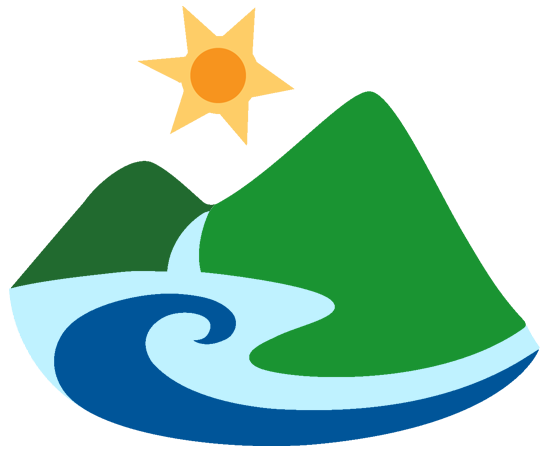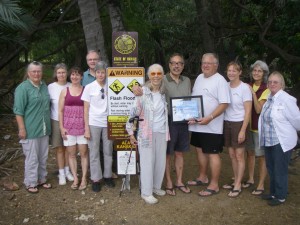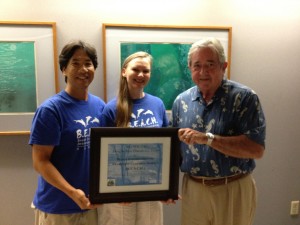Douglas Tom Thumbs-Up Award
The MACZAC Douglas Tom Thumbs-Up Award was established to recognize Hawaiʻi organizations that further the goals of MACZAC, advance the Coastal Zone Management (CZM) Program and its Ocean Resources Management Plan (ORMP), and actively engage the community.
The award is named in honor of Douglas Tom, Hawaiʻi’s long-serving, CZM Program manager whose tireless work as a steward of Hawaiʻi’s natural and cultural resources serves as a model for MACZAC’s Thumbs-Up recognition effort. Recipients of this award are selected and recognized annually by MACZAC.
Aha Moku ʻO Maui Inc. (https://www.ahamokuomaui.org/)
Nominated by Phil Fernandez
Aha Moku ʻO Maui Inc. was formed in 2011 because the moku of Maui wanted more input in Maui’s land and ocean resource management. The group is currently headed by Keʻaumoku Kapu, and is the only organization within the aha moku system that has organized and incorporated as a 501(c)(3). The group works to assist each moku on Maui in accomplishing goals by helping them build moku councils with participants from within their moku. The overall goal of Aha Moku ʻO Maui is to help build a system that works for all through implementation of moku resource management.
Conservation Council for Hawaiʻi (https://www.conservehi.org/)
Nominated by Robin Kaye
Conservation Council for Hawaiʻi (CCH) is a non-profit environmental organization established in 1950. The purpose of CCH is to protect native Hawaiian plants, animals, and ecosystems for future generations through research, education, community outreach, organizing, service, and advocacy.
Connecting Land and Sea – CCH continues to advocate for the proper management of game mammals and feral ungulates by the State to reduce the damage they cause to native forests, watersheds, habitats, streams, and near-shore water quality.
Preserving Our Ocean Heritage – For the past several years, CCH has been focused on helping to save the critically endangered Hawaiian monk seal. CCH convened a working group of environmental and native Hawaiian organizations to advocate on behalf of the monk seal. CCH is also currently monitoring efforts to protect nesting habitat of ʻaʻo (Newell’s shearwaters) and endangered ‘ua‘u (Hawaiian petrels) on Kaua‘i.
Promoting Collaboration and Stewardship – CCH sponsors gatherings and information exchange by native Hawaiian practitioners and others who actively manage ocean resources in their communities. With support from the Hawaiʻi Tourism Authority, CCH is producing dozens of wildlife viewing signs to promote responsible wildlife viewing and protection. CCH has produced annual wildlife education posters for children since 1975. The posters celebrate native species and ecosystems, and combine beautiful images by Hawaiʻi-based artists with in-depth information to promote stewardship of our natural and cultural resources.
CCH has called for the legal protection of sea turtles and the Hawaiian monk seal, opposed sand removal from public beaches on the Wai‘anae Coast of O‘ahu, opposed commercial whaling in the Pacific, prevented housing developments in Kawainui Marsh on O‘ahu, raised public support for the designation of the Hawaiian Islands Humpback Whale National Marine Sanctuary, and supported designation of Papahānaumokuākea Marine National Monument. CCH has also supported successful legislation aimed at reducing the environmental impacts of climate change.
Eyes of the Reef Network (https://eorhawaii.org/)
Nominated by Donna Brown
The Hawai‘i Eyes of the Reef Network (EOR) is an effective statewide reporting system for coral disease, bleaching, Crown of Thorns Sea Star (COTS) and marine invasive species that enables all community members and ocean users to contribute to the long-term protection of our local reefs. The Eyes of the Reef network is comprised of regular reef users, including recreational users, tourism professionals, researchers, and fishers, who voluntarily monitor and report on conditions at reefs that they visit regularly.
Pollution, climate change, poor land practices and increasing recreational and extractive activities create environmental conditions that foster coral disease and coral bleaching, support the spread of invasive species, and threaten reef health. Without initial sightings by the local “eyes” on our reefs, such occurrences may go unnoticed until it is too late. Detecting the early signs of any of these events on our local reefs requires a wide network of observers providing regular reports of conditions throughout the region. The Eyes of the Reef network has been designed to provide reliable reports on bleaching, disease, and changing reef conditions throughout Hawai‘i.
Hawai‘i’s reefs are numerous and widespread and scientists and managers are only able to monitor a small fraction of them. More trained eyes are needed to catch these events early on. Without these initial sightings by the local “eyes” on our reefs, such occurrences may go unnoticed until it is too late.
EOR offers free trainings to give people with all levels of ocean knowledge the skills to identify and report threats to Hawai‘i’s reefs. Contact your Island Coordinator to learn more about the programs available in your area.
The EOR statewide network is the first tier of a rapid response protocol developed by the Division of Aquatic Resources and the Climate Change and Marine Disease Local Action Strategy, implemented by Reef Check Hawai‘i.
Hawaiian Islands Humpback Whale National Marine Sanctuary (https://hawaiihumpbackwhale.noaa.gov/)
Nominated by Phil Fernandez
The Hawaiian Islands Humpback Whale National Marine Sanctuary was created by Congress in 1992 to protect humpback whales and their habitat in Hawaiʻi. It is administered by the Department of Commerce’s National Oceanic and Atmospheric Administration (NOAA) Office of National Marine Sanctuaries (ONMS). The sanctuary is located from the shoreline to the 100-fathom isobath (600 ft. depth) in the four island area of Maui; Penguin Bank; and off the north shore of Kauaʻi, the north and south shores of Oʻahu, and the north Kona and Kohala coast of Hawaiʻi Island.
The sanctuary is jointly managed via a cooperative federal-state partnership between the NOAA and the State of Hawaiʻi through the Department of Land and Natural Resources.
Hui Mālama O Moʻomomi Community Based Subsistence Fishing Area
Nominated by Kimbal Thompson and Craig Severance
Hui Mālama O Moʻomomi recently submitted a proposal to designate Moloka‘i’s northwest coast from ʻῙlio Point to Kaholaiki Bay, extending out one nautical mile from the high water shoreline, as a community-based subsistence fishing area (CBSFA). Subsistence is “the customary and traditional native Hawaiian uses of renewable ocean resources for direct personal or family consumption or sharing.” On Moloka‘i, 38% of the food consumed by residents of Hawaiian ancestry is produced by subsistence activities. Hui Mālama O Moʻomomi maintains an open invitation to any Hoʻolehua resident to be an active and participating member.
Community-Based Resource Management
Hui Mālama O Moʻomomi hopes to bring management from the State of Hawaiʻi and the Department of Land and Natural Resources to the community. Community-based resource management in partnership with State government can promote the sustainable use of fisheries resources more effectively and efficiently than government enforcement alone.
Benefits of Community-Based Resource Management
- Addresses the specific and dynamic needs of an area rather than relying on blanket state-wide rules and policies.
- Relies on peer and social pressure to enforce pono fishing practices in an area.
- Focuses on education – especially of youth who are the next generation of fishermen.
- Guided by kupuna fishermen and practitioners with in-depth knowledge of the area and its resources.
Protecting Threatened Species
Hui Mālama O Moʻomomi includes in its plan strategies that address the rapid depletion of the most threatened species. An approximate balance has been maintained between harvesting and replenishment of inshore marine resources. However, those species that have been specifically impacted to a greater degree necessitate enhanced regulatory measures. When the problem is alleviated, any kapu will be lifted.
Monitoring and Research
- Incorporates data gathered over the 20-year existence of Hui Mālama O Moʻomomi.
- Detailed observation and reporting of permitted fishing activities and catches.
- Repetitive surveys of spawning aggregations and koʻa.
- Small-scale experiments that allow study of species’ growth rates or allow comparison of population in fished and unfished areas.
- Scientific research shaped by fishermen’s observations.
Education
An educational program aimed at perpetuation of subsistence fishing knowledge and values in Hoʻolehua Homesteads and other Moloka‘i communities has been developed. Past educational efforts of Hui Mālama O Moʻomomi have included subsistence videos, a moon calendar based on the local fishery, dive classes to promote pono fishing to youth, lawaiʻa family fishing camp, community outreach and presentations at local, national, and international conferences.
Hui O Ka Wai Ola (https://huiokawaiola.weebly.com/)
Nominated by Donna Brown and Rich Brunner
Hui O Ka Wai Ola (Association of the Living Waters), a citizen science, coastal water quality monitoring program was launched under a joint effort from the Maui Nui Marine Resource Council, The Nature Conservancy, the West Maui Ridge to Reef Initiative and University of Hawaiʻi.
Hui O Ka Wai Ola is a group of water quality champions that is dedicated to measuring and sharing the status of Maui Nui’s ocean water. Comprised of community member volunteers, scientists, supporters, and partner groups, Hui O Ka Wai Ola recognizes the value of a clean ocean for all of Hawai’i’s residents, visitors, and natural resources. Hui O Ka Wai Ola’s Steering Committee guides volunteer efforts. Its members provide technical expertise and coordinate with the Department of Health to determine where, how, and when water quality is tested, and also what pollutants to look for.
Hui O Ka Wai Ola regularly measures coastal waters for pollutants, including nitrogen and phosphorus, which can harm Maui Nui’s coral reefs and human health. The State of Hawaiʻi sets limits for pollutants that, when exceeded, indicate that water quality is degraded. Hui O Ka Wai Ola compares water quality sample test results with these limits and can inform the affected communities and decision-makers when ocean waters need help. Through its work, Hui O Ka Wai Ola offers Maui Nui a more comprehensive and timely understanding of its water quality, and thus, its quality of life.
Lānaʻi Limu Restoration Project (LLRP) (https://www.facebook.com/Lanai-Limu-Restoration-Project-149271671761493/)
Nominated by Robin Kaye (former Lānaʻi Representative)
In operation for the past five years, LLRP has worked diligently to restore limu on the eastern shore of the island of Lānaʻi. A purely volunteer organization, LLRP was founded on the vision of kupuna Allen Kaiaokamalie, who passed away recently. Built on the kokua of Lānaʻi High and Elementary School and a host of community volunteers, LLRP has attempted to restore what was once a thriving environment of limu along the Keomoku coast, focusing particularly on the Maunalei area.
The LLRP attempted to re-establish ogo in two ways: on shore, in growing ponds, and in the ocean. The growing ponds were initially successful, but long term were not. The ocean process, however, has worked well, albeit with many modifications to the original efforts.
The LLRP is a perfect example of Douglas Tom’s award. It has become an island-wide advocate for restoration and preservation of the Lānaʻi reef; it has focused on “protection, beneficial use and development of the coastal zone; and it has worked diligently with the Lānaʻi High School.
Maui Nui Marine Resource Council’s Coral Reef Recovery Team (https://www.mnmrc.com/)
Nominated by Rich Brunner
The Maui Nui Marine Resource Council’s Coral Reef Recovery Team wrote a plan to restore fish, coral reefs, and water quality involving science and culture in the process. The Plan is now being proposed to the Maui County Council to be adopted into the Maui Island Plan. Sarah McLane, former Executive Director, spoke about the Plan at the 2013 MACZAC Meeting on Maui.
Plan Summary:
In 2010, the Maui Nui Marine Resource Council (MNMRC) established the
Maui Coral Reef Recovery Team (MCRT) composed of community members, scientists and cultural representatives, to develop a results-driven plan for the recovery of Maui’s coral reefs.
Based on documented decreases in both coral cover and reef fish populations, the Plan addresses the major causes (i.e., land-based sources of pollution, overfishing, deteriorating water quality, invasive algae, and climate change) of this decline, and increases the adaptability of Maui’s reefs to changing climates.
Plan Goals:
- Provide evidence of coral recovery at selected sites around Maui.
- Advance knowledge, improve understanding of the state of Maui’s coral reef ecosystems, and document coral recovery.
- Strengthen public awareness regarding the status of threats to and trends facing Maui’s coral reefs.
- Strengthen the capacity for effective coral reef management on Maui.
Moʻomomi Preserve
Nominated by Kimbal Thompson
Moʻomomi Preserve is a last stronghold of a major Hawaiian coastal ecosystem, a holdover from an ancient era. Strong and steady northeast trade winds shape the dunes of Moʻomomi, creating linear dunes a mile long and hundreds of feet wide. At first glance, these dunes appear nearly barren. Yet within these vast communities of native grasses and shrubs grow more rare coastal species than in any other single place in the main Hawaiian Islands.
The preserve harbors more than 22 native Hawaiian plant species, four of which are globally rare or endangered. These rare plants, like ʻakoko and ʻena ʻena, thrive in the dry, windy, salt-sprayed environment. A member of the sunflower family, Tetramolopium rockii, is known to be found only at Moʻomomi.
Moʻomomi Preserve is an important nesting site for the endangered green sea turtle. Deposits of bird bones reveal that the dunes were once home to at least 30 bird species, about one-third of which have since become extinct: a sea eagle, a Grallistrix or stilt owl, a flightless ibis, and a giant flightless duck, among others. The Hawaiian owl (pueo) is one of the few native land birds that can still be observed regularly at Moʻomomi. Native shorebirds, like sanderlings and plovers, and seabirds, like the great frigatebird (ʻiwa) and the wedge-tailed shearwater (ʻuaʻu kani), can also be seen along the shoreline.
Over time, most of Hawaiʻi’s native beaches have been lost to coastal development. Today, Moʻomomi Preserve, created in 1988, is the most intact beach and sand dune area in the main Hawaiian Islands.
Moʻomomi Preserve is managed by The Nature Conservancy in partnership with the State Department of Land & Natural Resources through the Natural Area Partnership Program. By protecting the dunes and beaches of Moʻomomi, the Conservancy is safeguarding native plants found nowhere else on earth. We’re also protecting habitat for the rare Hawaiian monk seal and seabirds like the Laysan albatross, in the hope that these species will once again colonize Moʻomomi’s pristine beaches.
Project S.E.A.-Link (https://www.projectsealink.org/)
Nominated by Jim Coon
Project S.E.A.-Link is a 501(c)(3) non-profit organization based on Maui, Hawaiʻi. Its mission is to promote marine Science, Education, and Awareness by fostering linkages between students, teachers, scientists, community members, other nonprofit organizations, governmental agencies, and the general public, and by encouraging and inspiring the next generation of marine scientists, educators, and conservationists.
Project S.E.A.-Link has developed and implemented numerous projects and programs focusing on marine science, conservation, and education, representing highly collaborative efforts characterized by extensive partnerships. These include launching the Reef Environmental Education Foundation (REEF) citizen science methodology in Hawaiʻi and developing an Adopt-a-REEF program, creating the Kānaka Mālama Kai volunteer marine naturalist program, assisting in the development and coordination of the (now statewide) Ocean Awareness Training program, managing a Honolua Bay stewardship/Makai Watch program, co-founding the Kāʻanapali Makai Watch program that focuses on promoting the effectiveness of the Kahekili Herbivore Fisheries Management Area, and spearheading the Changing Tides education and awareness campaign, which included the development of the “Take a Bite out of Fish Feeding” campaign. Project S.E.A.-Link also developed the publication Making a Difference – An Action Guide to Marine Conservation in Hawaiʻi. In addition, Project S.E.A.-Link worked with the Division of Aquatic Resources and other partners to develop interpretive signage (Respecting Coral Reefs and Kahekili Herbivore Fisheries Management Area), and currently coordinates an adopt-a-sign program to facilitate the sponsorship and installation of educational signage statewide. To date, over 50 Respecting Coral Reefs signs have been sponsored and installed across the state. Project S.E.A.-Link also serves as the fiscal sponsor for the West Maui Kumuwai social marketing campaign focused on watershed stewardship, supporting the community education objectives of the West Maui Ridge to Reef Initiative.
The West Maui Ridge to Reef (R2R) Initiative is an all-encompassing approach across multiple agencies and organizations to address adverse impacts to coral reefs in West Maui. The State recognized that an integrated and comprehensive approach to reduce land-based sources of pollution is one of the most important steps to help restore coral reef ecosystems. The R2R Initiative builds on already established efforts underway and leverages resources across a number of agencies and community groups to implement actions to reduce one of the key sources of reef decline – land-based sources of pollution.
Priority Status
The Hawaiʻi Coral Reef Strategy identified the coral reef ecosystem along the West Maui region as a priority management area. The US Coral Reef Task Force designated West Maui Watersheds as a priority partnership in the Pacific in 2011, beginning with Wahikuli and Honokōwai, and now including Kahana, Honokahua and Honolua. The full R2R project area includes 24,000 acres from Kāʻanapali northward to Honolua and from the summit of Puʻu Kukui to the outer reef.
Ongoing and Future Work
The R2R Initiative seeks to build on existing work in West Maui. The Watershed Management Plan for Wahikuli and Honokōwai funded by NOAA was completed in Dec 2012, and is now in the implementation phase. Planning for Kahana, Honokahua and Honolua Watersheds is underway and will be completed by early 2016.
Working Group
The working group is comprised of ten members that represent key interests in West Maui. It is chaired by Department of Land and Natural Resources, Division of Aquatic Resources (DLNR-DAR) and facilitated by the West Maui Watershed Coordinator. Members represent interests in agriculture, land development, resort operation, soil conservation, traditional Native Hawaiian knowledge, non-profit marine conservation, recreational ocean users, Maui County and fishing. The working group supports the R2R Initiative by serving as a local body providing community input to the Funding and Agency Support Team (see below).
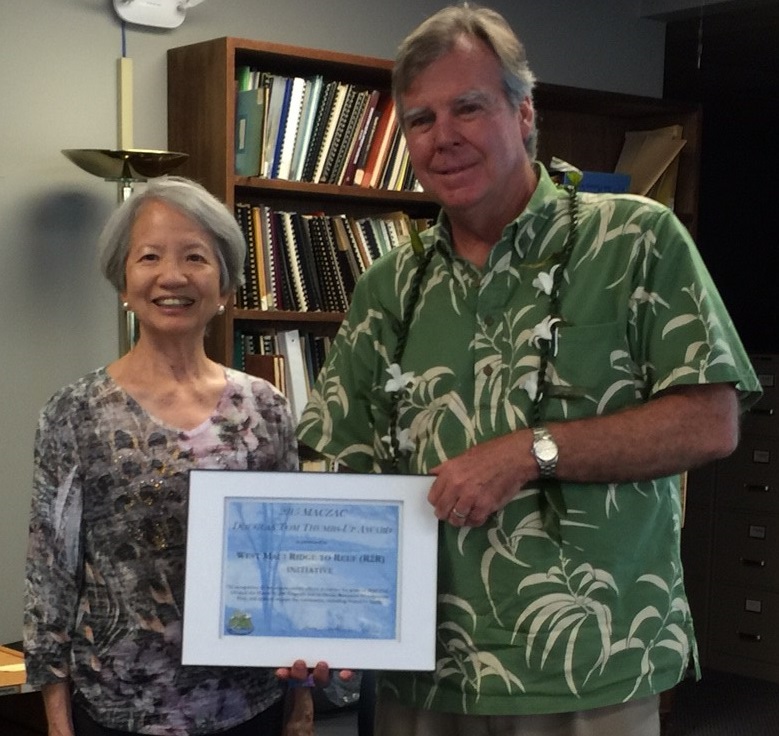
MACZAC Chair, Sue Sakai, presents the 2015 Douglas Tom Thumbs-Up Award to Bruce Anderson, DAR Administrator. DAR is a WMR2R partner agency.
University of Hawaiʻi Marine Option Program (MOP) is a University of Hawaiʻi system-wide Certificate program, offered on all UH campuses, providing educational opportunities for University of Hawaiʻi students from any field of study who are interested in the ocean.
Students in the MOP Certificate program have the opportunity to take marine-related coursework, and to conduct an independent research project or participate in an internship in a marine-related field. The MOP Certificate program provides students with experiential education, research opportunities, networking, job opportunities, field trips, and the opportunity to pursue their passion for marine studies.
The MOP Certificate is awarded to students who have completed a specialized marine-focused course of study, including required coursework and an independent Skill Project. The MOP Certificate is similar to a minor, and is awarded to students who successfully complete 12-16 credit hours of marine-related courses, IS 100 (MOP Seminar) as well as a MOP Skill Project. The MOP Certificate is an official University of Hawaiʻi Certificate that is registered on the student’s transcript.

MACZAC members present the 2014 Thumbs-Up Award to Dr. Cynthia Hunter, MOP Coordinator (fourth from left), accepting the award at the June 1, 2015 MACZAC Meeting for each of the nine UH campuses where MOP is available. With Dr. Hunter in the photo are (from left to right): MACZAC members Phil Fernandez, Craig Severance, Donna Brown, James Coon, Dawn Hegger, Rich Brunner, Robin Kaye, and Shaylyn Kimura, and MACZAC Chair Sue Sakai.
Ka Honua Momona (KHM) is a 501(c) (3) nonprofit organization, based on the island of Moloka‘i. KHM’s mission is to be a model of sustainability – mauka to makai (from the mountains to the sea). They seek to foster connections between all aspects of the island ecosystem, including the people and culture, and firmly believe that Moloka‘i can again return to abundance and become a self-sufficient model for all nations. Their primary long-term goals are to:
- Develop indigenous education systems by revitalizing natural and cultural resources.
- Perpetuate traditional knowledge and stewardship while evolving with modern technology.
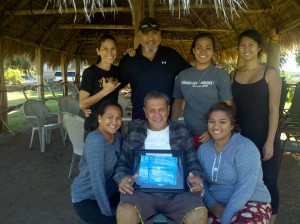
Former MACZAC member Mike Sabas of Moloka‘i presents the 2013 Douglas Tom Thumbs-Up Award to members of Ka Honua Momona.
E Mau Na Ala Hele is a community-based 501(c) (3) non-profit organization, established in 1979, devoted to preserving and perpetuating the historic trails of Hawaiʻi and the protection of historic and natural areas adjacent to the trails.
E Mau Na Ala Hele partners with both State and Federal agencies in trail advocacy, preservation, and stewardship, providing volunteers and seeking funding for trail projects.
MACZAC member Phil Fernandez of West Hawaiʻi presents the 2013 Douglas Tom Thumbs-Up Award to volunteers of E Mau Na Ala Hele Barbara Schaefer, Alice Jenkins, Alison Martyn, Keith Wallis, Clare Wilson, Toni Thomson, Frank Dickinson, Martha Tumbleson, Christine Ahia, and Sonja Walawender.
Beach Environmental Awareness Campaign Hawaiʻi (B.E.A.C.H.) is an all volunteer, non-profit organization that brings awareness and solutions to the problem of marine debris on Hawaiʻi’s beaches through environmental education, marine debris removal and research, and plastic reduction and litter prevention campaigns.
MACZAC Vice-Chair Kimbal Thompson presents the 2012 Douglas Tom Thumbs-Up Award to B.E.A.C.H. volunteers Suzanne Frazer and Dean Otsuki.
